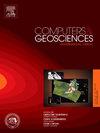Enhancing 3D migration images resolution: A fast and robust implicit point spread function deconvolution method based on wavenumber domain representation
IF 4.2
2区 地球科学
Q1 COMPUTER SCIENCE, INTERDISCIPLINARY APPLICATIONS
引用次数: 0
Abstract
Image-domain least-squares migration has been proven effective in enhancing the spatial resolution of migration images. However, due to the intrinsic complexity of the 3D problem, the conventional local-stationary deblurring method cannot achieve a good balance between computational efficiency and deblurring accuracy. The explicit point spread function (PSF) deconvolution method has been proposed to improve the resolution of migration images on a point-wise bias with substantial computational and storage costs, especially for the 3D PSF deconvolution. To achieve high-resolution imaging with reduced costs, we introduce an implicit PSF deconvolution method based on wavenumber domain representation to enhance the resolution of 3D migration images. Using a deep-learning optimizer, coupled with a corresponding modified hyperparameter, we can achieve a fast convergence for the solution of the 3D PSF deconvolution operator. A loss interpolation technique is introduced to obtain non-sensitive PSF deconvolution operators for dense interpolation to reduce high-frequency artifacts. 3D synthetic and large-scale field dataset results demonstrate that our approach can produce high-resolution images with reduced migration artifacts and balanced amplitude. Additionally, our proposed method outperforms existing methods with at least three times computational cost reduction and two orders of magnitude reduction in storage cost for the 3D PSF deconvolution. It demonstrates that the proposed approach can be a cost-effective and practical high-resolution imaging tool for large-scale 3D datasets.
求助全文
约1分钟内获得全文
求助全文
来源期刊

Computers & Geosciences
地学-地球科学综合
CiteScore
9.30
自引率
6.80%
发文量
164
审稿时长
3.4 months
期刊介绍:
Computers & Geosciences publishes high impact, original research at the interface between Computer Sciences and Geosciences. Publications should apply modern computer science paradigms, whether computational or informatics-based, to address problems in the geosciences.
 求助内容:
求助内容: 应助结果提醒方式:
应助结果提醒方式:


